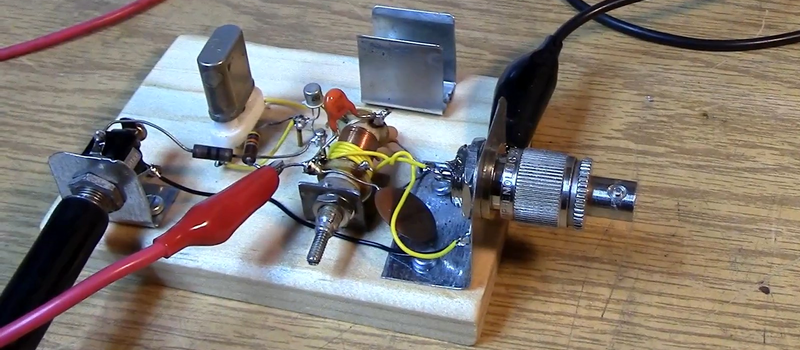When you get to a certain age, you get unsettled by people calling “your” music oldies. That’s how a few of us felt when we saw [Mikrowave1’s] video about Retro QRP – Solid Gold Years (see below). “QRP” is the ham radio term for low power operation, and the “solid gold” years in question are the 1960s to 1980. The videox has some good stuff, including some old books and some analysis of a popular one-transistor design from that time. He even tries a few different period transistors to see which works best.
[Mikrowave1] talks about the construction techniques used in that time frame, old transistors, and some vintage test equipment. You can even see an old ARC-5 command receiver in use to listen to the transmitter. These were made for use in military aircraft and were very common as surplus.
After analyzing the tiny transmitter with a scope and some other gear, [Mikrowave1] makes a real contact using the transmitter and the ARC-5. With 300 mW, he made a Morse code contact with a station over 375 miles away. Not bad!
At the end, he uses a communication monitor to measure the harmonic output of the transmitter. In one sense, it is considerable, but, of course, the low power limits the harmonics too. Adding a filter (which he does) cleans things up considerably. After showing the better output, he makes a 350-mile contact.
We recently covered a transmitter in a walnut shell, that wasn’t much different. If you want to learn more about how hams use QRP — low power operation — you can check out [Dan’s] post on that subject.

















QRP is neat, but man it’s come a long way. Hackaday did an article on the BITX40 QRP SSB rig a few months ago, and so I went and bought one. They now come with a DDS VFO and everything for $59. Just add a box and a dipole! The Unofficial BITX40 FAQ has info on it if anyone is interested: http://miscdotgeek.com/unofficial-bitx40-faq/
Thanks for the video. Enjoyed it and was educated. I built several Michigan Mighty Mite style TXs and they put out an outrageous half watt at 12v. But now am in China and not allowed ham activity. Looking forward to normalizing my QTH and have some QSOs on my QRP rigs. (Michigan Mighty Mite: http://www.qsl.net/wb5ude/kc6wdk/transmitter.html)
Why are you not allowed to do ham activity in China? That’s unfortunate because of the sheer amount of cool ham radio equipment available on Taobao that would probably arrive on your doorstep within a day or two.
Well technically it is possible but there is a lot of regulation, must operate at a club site and cannot set up own station. Here are regs: http://www.crac.org.cn/?p=1646 I am at a backwaters place not near a club. So out of luck.
Also, you are right about taobao.com. Love it. Use if for my rc hobby and electronic components. Very inexpensive stuff here. As far as ham equipment, mostly qrp kits although saw x108G radio for about $400 for a while which retails in US for $600.
Yea, I lived in China for a while, and it was unbelievable what you could have the next day via Taobao. Although when I was there, it was before I got into ham radio, it was mostly electro-mechanical, connectors, and SMT components. The X108G is supposed to be pretty good, I’d buy one at that price, if not just to mess around with.
Regarding the regulations, who hard would it be to set up a one-person club where you’re located? Assuming you’ve got factories in the area, there are bound to be a few engineers that might be willing to join, too, even if it’s out in the sticks.
Never thought of having someone start a club here. I just got PL600 radio to monitor the area for cw traffic. Don’t know if I could find a student willing to try to pass their exam. Will have someone look at that though. Good idea and thanks. Unfortunately this is a small city and their are no factories here. Perhaps one of the engineering students might want to give it a go.
If you’ve got engineering students around, it’s probably worth trying :) They’ll get a lot of practical learning that they may not get in their classroom.
Talking to young people about retro-stuff just makes me sad.
The other day I heard someone calling the original Ninja Turtles “the retro turtles”
Music from the 1980’s can be retro, I don’t see why their cartoons can’t be.
Music from the 80’s was retro 10 years ago. Music from the 90’s is retro now.
Thanks for the video. I’ve been building simple QRP rigs since the late 70’s. I still fire them up once in a while along with my HW-8 and FT817.
Interesting. Oh and Classical Music is alive and well.
Check out my little hand made QRP transmitters: http://bit.ly/KeychainQRP
I’ve updated my website with the circuit diagram of my 8 watt QRP shortwave transmitter and inverted-v antenna.
I’m sure it’s of interest to fellow (shortwave) radio enthusiasts.
Here’s the link: http://www.stationqrp.com
73’s
Jack